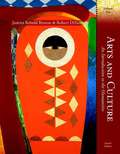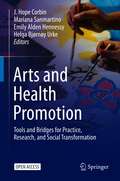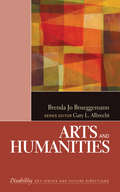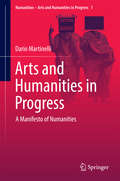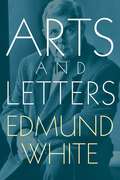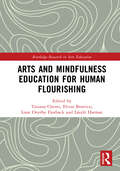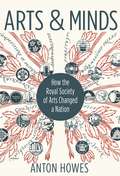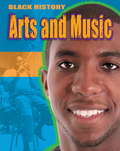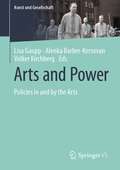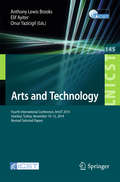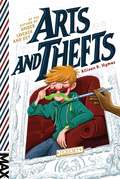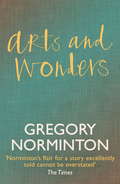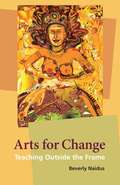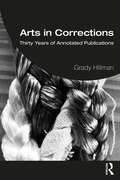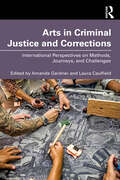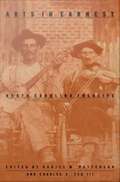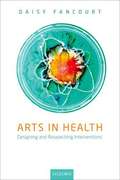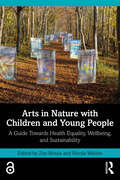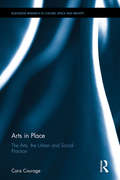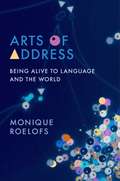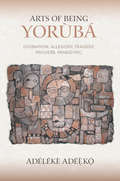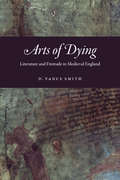- Table View
- List View
Arts and Culture: An Introduction to the Humanities
by Robert Diyanni Janetta Rebold BentonFor one semester/quarter courses on Introduction to the Humanities or Cultural Studies. Now in full color, Arts and Culture provides an introduction to global civilizations and their artistic achievements, history, and cultures. The authors consider two important questions: What makes a work a masterpiece of its type? And what qualities of a work enable it to be appreciated over time? Critical thinking is also highlighted throughout the text with 4 different box features that ask students to explore connections across the humanities and different cultures. These boxes are entitled Connections, Cross Currents, Then & Now, and Cultural Impact boxes. Open the new fourth edition of Arts and Culture and open a world of discovery.
Arts and Culture: An Introduction to the Humanities, Volume I
by Janetta Rebold Benton Robert DiYanniFor one semester/quarter courses on Introduction to the Humanities or Cultural Studies. <p><p>Now in full color, Arts and Culture provides an introduction to global civilizations and their artistic achievements, history, and cultures. The authors consider two important questions: What makes a work a masterpiece of its type? And what qualities of a work enable it to be appreciated over time? Critical thinking is also highlighted throughout the text with 4 different box features that ask students to explore connections across the humanities and different cultures. These boxes are entitled Connections, Cross Currents, Then & Now, and Cultural Impact boxes. Open the new fourth edition of Arts and Culture and open a world of discovery.
Arts and Health Promotion: Tools and Bridges for Practice, Research, and Social Transformation
by J. Hope Corbin Mariana Sanmartino Emily Alden Hennessy Helga Bjørnøy UrkeThis open access book offers an overview of the beautiful, powerful, and dynamic array of opportunities to promote health through the arts from theoretical, methodological, pedagogical, and critical perspectives. This is the first-known text to connect the disparate inter-disciplinary literatures into a coherent volume for health promotion practitioners, researchers, and teachers. It provides a one-stop depository for using the arts as tools for health promotion in many settings and as bridges across communities, cultures, and sectors. The diverse applications of the arts in health promotion transcend the multiple contexts within which health is created, i.e., individual, community, and societal levels, and has a number of potential health, aesthetic, and social outcomes. Topics covered within the chapters include: Exploring the Potential of the Arts to Promote Health and Social Justice Drawing as a Salutogenic Therapy Aid for Grieving Adolescents in Botswana Community Theater for Health Promotion in Japan From Arts to Action: Project SHINE as a Case Study of Engaging Youth in Efforts to Develop Sustainable Water, Sanitation, and Hygiene Strategies in Rural Tanzania and India Movimiento Ventana: An Alternative Proposal to Mental Health in Nicaragua Using Art to Bridge Research and Policy: An Initiative of the United States National Academy of Medicine Arts and Health Promotion is an innovative and engaging resource for a broad audience including practitioners, researchers, university instructors, and artists. It is an important text for undergraduate- and graduate-level courses, particularly in program planning, research methods (especially qualitative methodology), community health, and applied art classes. The book also is useful for professional development among current health promotion practitioners, community nurses, community psychologists, public health professionals, and social workers.
Arts and Humanities (The SAGE Reference Series on Disability: Key Issues and Future Directions)
by Brenda Jo BrueggemannThis volume in The SAGE Reference Series on Disability explores the arts and humanities within the lives of people with disabilities. It is one of eight volumes in the cross-disciplinary and issues-based series, which incorporates links from varied fields making up Disability Studies as volumes examine topics central to the lives of individuals with disabilities and their families. With a balance of history, theory, research, and application, specialists set out the findings and implications of research and practice for others whose current or future work involves the care and/or study of those with disabilities, as well as for the disabled themselves. The presentational style (concise and engaging) emphasizes accessibility. Taken individually, each volume sets out the fundamentals of the topic it addresses, accompanied by compiled data and statistics, recommended further readings, a guide to organizations and associations, and other annotated resources, thus providing the ideal introductory platform and gateway for further study. Taken together, the series represents both a survey of major disability issues and a guide to new directions and trends and contemporary resources in the field as a whole.
Arts and Humanities in Progress: A Manifesto of Numanities (Numanities - Arts and Humanities in Progress #1)
by Dario MartinelliThe book aims to introduce a research concept called "Numanities", as one possible attempt to overcome the current scientific, social and institutional crisis of the humanities. Such crisis involves their impact on, and role within, society; their popularity among students and scholars; and their identity as producers and promoters of knowledge. The modern western world and its economic policies have been identified as the strongest cause of such a crisis. Creating the conditions for, but in fact encouraging it. However, a self-critical assessment of the situation is called for. Our primary fault as humanists was that of stubbornly thinking that the world's changes could never really affect us, as - we felt - our identity was sacred. In the light of these approaches, the main strengths of humanities have been identified in the ability to: promote critical thinking and analytical reasoning; provide knowledge and understanding of democracy and social justice; develop leadership, cultural and ethical values. The main problems of humanities are the lack economic relevance; the socio-institutional perception of them as "impractical" and unemployable; the fact that they do not match with technological development. Finally, the resulting crisis consists mainly in the absence (or radical reduction) of funding from institutions; a decrease in student numbers a decrease in interest; a loss of centrality in society. A Numanities (New Humanities) project should consider all these aspects, with self-critical assessment on the first line. The goal is to unify the various fields, approaches and also potentials of the humanities in the context, dynamics and problems of current societies, and in an attempt to overcome the above-described crisis. Numanities are introduced not as a theoretical paradigm, but in terms of an "umbrella-concept" that has no specific scientific content in it: that particularly means that the many existing new fields and research trends that are addressing the same problems (post-humanism, transhumanism, transformational humanities, etc. ) are not competitors of Numanities, but rather possible ways to them. Therefore, more than a theoretical program, Numanities intend to pursue a mission, and that is summarized in a seven-point manifesto. In the light of these premises and reflections, the book then proceeds to identify the areas of inquiry that Numanities, in their functions and comprehensive approach, seek to cover. The following list should also be understood as a statement of purposes for this entire book series. These, in other words, will be the topics/areas we intend to represent. Once elaborated on the foundations of Numanities, the book features a second part that presents two case studies based on two relatively recent (and now updated) investigations that the author has performed in the fields of musical and animal studies respectively. The two cases (and relative areas of inquiry) were selected because they were considered particularly relevant within the discussion of Numanities, and in two different ways. In the first case-study the author discussed the most typical result (or perhaps cause?) of the technophobic attitude that was addressed in the first part of the book: the issue of "authenticity", as applied, in the author's particular study, to popular music. In the second case-study, he analyzes two different forms of comparative analysis between human and non-human cognition: like in the former case, this study, too, is aimed at a critical commentary on (what the author considers) redundant biases in current humanistic research - anthropocentrism and speciesism.
Arts and Letters
by Edmund WhiteA dazzling collection of profiles and interviews by the preeminent American cultural essayist of our time. In these 39 lively essays and profiles, best-selling novelist and biographer Edmund White draws on his wide reading and his sly good humor to illuminate some of the most influential writers, artists, and cultural icons of the past century: among them, Marcel Proust, Catherine Deneuve, George Eliot, Andy Warhol, André Gide, David Geffen, and Robert Mapplethorpe. Whether he's praising Nabokov's sensuality, or critiquing Elton John's walk ("as though he's a wind-up doll that's been overwound and sent heading for the top of the stairs"), or describing serendipitous moments in his seven-year-long research into the life of Genet, White is unfailingly observant, erudite, and entertaining.
Arts and Mindfulness Education for Human Flourishing (Routledge Research in Arts Education)
by László HarmatThis edited volume explores the role of arts and meditation within educational settings, and looks in particular at the preventive and developmental function of the arts in educational contexts through different theoretical perspectives. Encompassing research from an array of disciplines including theatre, psychology, neuroscience, music, psychiatry, and mindfulness, the book draws insights relevant to a broad spectrum of interdisciplinary fields. Chapters are divided into thematic sections, each outlining praxes and emphasising how educating within and through the arts can provide tools for critical thinking, creativity and a sense of agency, consequently fulfilling the need of well-being and contributing towards human flourishing. Ultimately, the book focuses on the role the arts have played in our understanding of physical and mental health, and demonstrates the new-found significance of the discipline in the wake of the COVID-19 pandemic. With its interdisciplinary and timely nature, this book will be essential reading for scholars, academics, and post-graduate researchers in the field of arts education, creative therapies, neuroscience, psychology, and mindfulness.
Arts and Minds: How the Royal Society of Arts Changed a Nation
by Anton HowesA major new history of the extraordinary society that has touched all aspects of British lifeFrom its beginnings in a coffee house in the mid-eighteenth century, the Royal Society for the Encouragement of Arts, Manufactures and Commerce has tried to improve British life in every way imaginable. It has sought to influence how Britons work, how they are educated, the music they listen to, the food they eat, the items in their homes, and even how they remember their own history. Arts and Minds is the remarkable story of an institution unlike any other—a society for the improvement of everything and anything.Drawing on exclusive access to a wealth of rare papers and artefacts from the Society's own archives, Anton Howes shows how this vibrant and singularly ambitious organisation has evolved and adapted, constantly having to reinvent itself to keep in step with changing times. The Society has served as a platform for Victorian utilitarian reformers, purchased and restored an entire village, encouraged the planting of more than sixty million trees, and sought technological alternatives to child labour. But this is more than just a story about unusual public initiatives. It is an engaging and authoritative history of almost three centuries of social reform and competing visions of a better world—the Society's members have been drawn from across the political spectrum, including Adam Smith, Edmund Burke, and Karl Marx.Informative and entertaining, Arts and Minds reveals how a society of public-spirited individuals tried to make their country a better place, and draws vital lessons from their triumphs and failures for all would-be reformers today.
Arts and Music (Black History #2)
by Dan Lyndon-CohenWhether you enjoy listening to music, reading books and poetry, watching films or visiting art museums, the contributions made by artists and performers of African origin are all around you. Rising out of the shackles of slavery in centuries past, to increased recognition in this new century, it is clear that black people have made an enormous contribution to culture around the world. This book looks at the influences and key movements in the development of black artists and their work across the generations.The Black History series brings together a wide range of events and experiences from the past to promote knowledge and understanding of black culture today. This book looks at the influences and key movements in the development of black artists and their work across the generations.
Arts and Power: Policies in and by the Arts (Kunst und Gesellschaft)
by Volker Kirchberg Lisa Gaupp Alenka Barber-KersovanThe focus on concepts of power and domination in societal structures has characterized sociology since its beginnings. Max Weber’s definition of power as “imposing one’s will on others” is still relevant to explaining processes in the arts, whether their production, imagination, communication, distribution, critique or consumption. Domination in the arts is exercised by internal and external rulers through institutionalized social structures and through beliefs about their legitimacy, achieved by defining and shaping art tastes.The complexity of how the arts relate to power arises from the complexity of the policies of artistic production, distribution and consumption—policies which serve to facilitate or hinder an aesthetic object from reaching its intended public. Curators, critics and collectors employ a variety of forms of cultural and artistic communication to mirror and shape the dominant social, economic and political conditions.Arts and Power: Policies in and by the Arts brings together diverse voices who position the societal functions of art in fields of domination and power, of structure and agency—whether they are used to impose hegemonic, totalitarian or unjust goals or to pursue social purposes fostering equal rights and grassroots democracy. The contributions in this volume are exploratory steps towards what we believe can be a more systematic, empirically and theoretically founded sociological debate on the arts and power. And they are an invitation to take further steps.
Arts and Science at Toronto
by Craig BrownThe University of Toronto's Faculty of Arts and Science is older than the university itself. Chartered in 1827 as King's College, it officially opened in 1843 with four professors and twenty-seven students. In this lively and engaging book, Robert Craig Brown vividly recounts the 150-year history of the faculty's staff, students, and achievements.Brown takes readers on a sweeping journey though the development and growth of the faculty through wartime and peace, depression and prosperity. He covers teaching and research in the vast array of subjects offered, administrative and financial concerns, and the Faculty's significant contributions to higher education in Canada. Throughout, Brown traces how the faculty evolved past its early defining traits of elitism and exclusivity to its current form - a remarkably diverse body with students of all ages, backgrounds, and academic interests.
Arts and Technology: Fourth International Conference, ArtsIT 2014, Istanbul, Turkey, November 10-12, 2014, Revised Selected Papers (Lecture Notes of the Institute for Computer Sciences, Social Informatics and Telecommunications Engineering #145)
by Anthony Lewis Brooks Elif Ayiter Onur YazicigilThis book constitutes the thoroughly refereed proceedings of the Fourth International Conference on Arts and Technology, ArtsIT 2014, held in Istanbul, Turkey, in November 2014. The 17 revised full papers presented were carefully selected and reviewed from numerous submissions. ArtsIT has become a leading scientific forum for the dissemination of cutting-edge research results in the area of arts, design and technology. The papers focus on IT technologies, artists, designers and industrial members and offer content creators tools that expand the means of expression of the traditional design field.
Arts and Thefts (MAX)
by Allison K. HymasMiddle school retrieval specialist Jeremy Wilderson must team up with preteen private detective Becca Mills once again to solve his most mind-boggling case yet in this action-packed MAX novel.Ahh, summer vacation! Jeremy Wilderson, Scottsville Middle School’s first (and only) retrieval specialist, is enjoying a slower-than-usual season of retrieving (NOT stealing) lost objects in order to help the under thirteen population of Scottsville. But crime doesn’t take a vacation! And when sabotage strikes Scottsville’s event of the year—the Summer Art Show—threatening to ruin the burgeoning painting career of Jeremy’s best friend, Case, it’s up to Jeremy to figure out what’s going on. Of course, his archrival Becca Mills, who just happens to think Jeremy, Case, and their friend Hack are involved in the crime, is also looking into it. Jeremy has only a few precious hours to stop the sabotage before more contest entries—and kids’ dreams—are slashed and burned. But Jeremy’s specialty is retrieval…not detective work! The only solution is to team up with Becca to solve the case, something Jeremy’s not exactly thrilled to do. Not to mention, he has to keep his alliance with Becca a secret from Case and Hack, who will disown him if they see him working with the enemy. Somewhere between being stuck inside an air vent and slathered in red paint, Jeremy has to wonder: is he in over his head?
Arts and Wonders
by Gregory NormintonARTS AND WONDERS spans a glorious canvas, peopled by werewolves, thieves, emperors, travelling players and a forger dwarf who takes a lifetime to learn the danger of illusions.Tomasso Grilli, a dwarf gifted with an extraordinary capacity for artistic forgery (and flexible morals) recounts the story of his life, from his base beginnings in Florence, through his apprenticeship to the painter Arcimboldo, to his life of crime in Prague and subsequent banishment, to the gilded fame he finds as 'librarian' and collector to the court of an impoverished, ignorant ruler in the German Dukedom of Felsungrunde. Grilli's ambition and dubious skills take him to the pinnacle of success only for it to collapse beneath him like the illusion it always was. Betrayed and reviled he leaves Felsungrunde, is forced to join a group of travelling players, and finally learns the value of friendship. loyalty and honesty. The extraordinary cast of characters (some based on real historical figures) includes werewolves, an occult alchemist, a bear, a dodo, a lion and a maker of mechanical dolls.
Arts and Wonders
by Gregory NormintonARTS AND WONDERS spans a glorious canvas, peopled by werewolves, thieves, emperors, travelling players and a forger dwarf who takes a lifetime to learn the danger of illusions.Tomasso Grilli, a dwarf gifted with an extraordinary capacity for artistic forgery (and flexible morals) recounts the story of his life, from his base beginnings in Florence, through his apprenticeship to the painter Arcimboldo, to his life of crime in Prague and subsequent banishment, to the gilded fame he finds as 'librarian' and collector to the court of an impoverished, ignorant ruler in the German Dukedom of Felsungrunde. Grilli's ambition and dubious skills take him to the pinnacle of success only for it to collapse beneath him like the illusion it always was. Betrayed and reviled he leaves Felsungrunde, is forced to join a group of travelling players, and finally learns the value of friendship. loyalty and honesty. The extraordinary cast of characters (some based on real historical figures) includes werewolves, an occult alchemist, a bear, a dodo, a lion and a maker of mechanical dolls.
Arts for Change: Teaching Outside the Frame
by Beverly NaidusBeverly Naidus shares her passion and strategies for teaching socially engaged art, offering, as well, a short history of the field and the candid views of more than thirty colleagues. A provocative, personal look at the motivations and challenges of teaching socially engaged arts, Arts for Change overturns conventional arts pedagogy with an activist's passion for creating art that matters.How can polarized groups work together to solve social and environmental problems? How can art be used to raise consciousness? Using candid examination of her own university teaching career as well as broader social and historical perspectives, Beverly Naidus answers these questions, guiding the reader through a progression of steps to help students observe the world around them and craft artistic responses to what they see. Interviews with over 30 arts education colleagues provide additional strategies for successfully engaging students in what, to them, is most meaningful.
Arts in Corrections: Thirty Years of Annotated Publications
by Grady HillmanIn Arts in Corrections, the author—a poet, translator and teacher—takes readers on a chronological journey through an annotated selection of 24 of his own publications from 1981 to 2014 which recount his experiences teaching, consulting and documenting US arts programs in prisons, jails and juvenile facilities. Anyone interested in corrections and arts-in-corrections will be drawn in by the poetic sensibility Hillman brings to his writing. Readers will gain a historical and personal perspective not only into correctional arts programming in the US over the last 40 years, but also the institutional transformations in policy, culture, populations, economics, and the criminological mission expansion into other institutional settings like K-12 education. Original essays, articles, monographs and poems are interspersed with recent annotations to deliver not only a top-down view of the correctional system but also the author’s personal journey of "discouragement and hope" from work conducted in approximately 200 adult and juvenile facilities in 30 states and six countries. This comprehensive book is essential reading for a broad cross-section of international readers interested in and involved in the arts-in-corrections field. With two million individuals behind bars in the US at any given time, the profile of arts programs in prisons and jails is rising and interest in criminal-justice matters more generally is increasing. This includes not only arts-in-corrections professionals, policy makers, students, researchers, advocates and academics, but professionals in multiple other fields as well as the general public.
Arts in Criminal Justice and Corrections: International Perspectives on Methods, Journeys, and Challenges
by Amanda Gardner and Laura CaulfieldOffering a lively, international, and interdisciplinary introduction to research on arts programmes in prisons, Arts in Criminal Justice and Corrections is the first volume to bring together leading figures from the USA, the UK, Australia, New Zealand, and Belgium to explore key methodological approaches and issues through the lens of the researchers themselves.Beginning with the original pioneers of research into the arts in corrections in the USA in the 1980s, this book highlights the role of researchers in evidencing impact and influencing policy. Contributors include those who were themselves once incarcerated and those who have transitioned from practitioner to criminologist. Chapters lay the groundwork for discussion on how an important avenue for rehabilitation and re-entry can be developed, providing a call to action for more research into a field which holds promise for building a more just, equitable, and inclusive society.This book is essential reading for criminologists engaged in prisons, corrections, and desistance research, as well as researchers and practitioners in the arts and rehabilitation.
Arts in Earnest: North Carolina Folklife
by Daniel W. Patterson Charles G. Zug IIIArts in Earnest explores the unique folklife of North Carolina from ruddy ducks to pranks in the mill. Traversing from Murphy to Manteo, these fifteen essays demonstrate the importance of North Carolina's continually changing folklife. From decoy carving along the coast, to the music of tobacco chants and the blues of the Piedmont, to the Jack tales of the mountains, Arts in Earnest reflects the story of a people negotiating their rapidly changing social and economic environment. Personal interviews are an important element in the book. Laura Lee, an elderly black woman from Chatham County, describes the quilts she made from funeral flower ribbons; witnesses and friends each remember varying details of the Duke University football player who single-handedly vanquished a gang of would-be muggers; Clyde Jones leads a safari through his backyard, which is filled with animals made of wood and cement that represent nontraditional folk art; the songs and sermon of a Primitive Baptist service flow together as one--"it tills you up all over"; Durham bluesman Willie Trice, one of a handful of Durham musicians who recorded in the 1930s and early 1940s, remembers when the active tobacco warehouses offered ready audiences--"They'd tip us a heap of change to play some music"; and Goldsboro tobacco auctioneer H. L. "Speed" Riggs chants 460 words per minute, five to six times faster than a normal conversational rate.
Arts in Health: Designing and Researching Interventions
by Daisy FancourtArts in Health: Designing and Researching Interventions provides a complete overview of how to go about undertaking research and practice in the field of arts in health. It starts by exploring the context for arts in health interventions, including the history of the use of arts in health and the theoretical and political developments that have laid the foundations for its flourishing. It also considers what 'arts in health' encompasses and the range of disciplines involved. Part II examines how to design an arts in health intervention, develop partnerships and find funding and considers the sensitivities around working in healthcare. Part III considers the value of research for the field of arts in health and how to design and undertake a research project. Part IV provides a fact file of arts in health research and practice, showing how the arts can be applied and the benefits they can bring across a range of medical disciplines. The book will be valuable for researchers, practitioners, healthcare professionals and those interested in learning more about the field.
Arts in Nature with Children and Young People: A Guide Towards Health Equality, Wellbeing, and Sustainability
by Nicola Walshe Zoe MoulaThis novel text brings together research and practice on the intersection between arts and nature and their impact on children and young people’s wellbeing, health equality and sustainability.Existing literature focuses on either the impact of the arts or the impact of being in/with nature on children’s and young people’s wellbeing. However, the intersection between the two – arts and nature – and their combined effect on wellbeing has received limited attention. Through five research-based and seven practice-based chapters, this book draws upon arts-in-nature practices that incorporate visual arts, music, movement, drama and poetry, in a range of natural environments, such as forests, beaches, greenhouses, parks, community areas and school playgrounds.Arts in Nature with Children and Young People will appeal to anyone working with children and young people, including mental health and healthcare professionals, teachers, researchers, artists, and arts therapists. It is also an accessible guide for parents and families looking for inspiration and ideas for creative and outdoor activities.
Arts in Place: The Arts, the Urban and Social Practice (Routledge Research in Culture, Space and Identity)
by Cara CourageThis interdisciplinary book explores the role of art in placemaking in urban environments, analysing how artists and communities use arts to improve their quality of life. It explores the concept of social practice placemaking, where artists and community members are seen as equal experts in the process. Drawing on examples of local level projects from the USA and Europe, the book explores the impact of these projects on the people involved, on their relationship to the place around them, and on city policy and planning practice. Case studies include Art Tunnel Smithfield, Dublin, an outdoor art gallery and community space in an impoverished area of the city; The Drawing Shed, London, a contemporary arts practice operating in housing estates and parks in Walthamstow; and Big Car, Indianapolis, an arts organisation operating across the whole of this Midwest city. This book offers a timely contribution, bridging the gap between cultural studies and placemaking. It will be of interest to scholars, students and practitioners working in geography, urban studies, architecture, planning, sociology, cultural studies and the arts.
Arts of Address: Being Alive to Language and the World (Columbia Themes in Philosophy, Social Criticism, and the Arts)
by Monique RoelofsModes of address are forms of signification that we direct at living beings, things, and places, and they at us and at each other. Seeing is a form of address. So are speaking, singing, and painting. Initiating or responding to such calls, we participate in encounters with the world. Widely used yet less often examined in its own right, the notion of address cries out for analysis.Monique Roelofs offers a pathbreaking systematic model of the field of address and puts it to work in the arts, critical theory, and social life. She shows how address props up finely hewn modalities of relationality, agency, and normativity. Address exceeds a one-on-one pairing of cultural productions with their audiences. As ardently energizing tiny slippages and snippets as fueling larger impulses in the society, it activates and reaestheticizes registers of race, gender, class, coloniality, and cosmopolitanism. In readings of writers and artists ranging from Julio Cortázar to Jamaica Kincaid and from Martha Rosler to Pope.L, Roelofs demonstrates the centrality of address to freedom and a critical political aesthetics. Under the banner of a unified concept of address, Hume, Kant, and Foucault strike up conversations with Benjamin, Barthes, Althusser, Fanon, Anzaldúa, and Butler. Drawing on a wide array of artistic and theoretical sources and challenging disciplinary boundaries, the book illuminates address’s significance to cultural existence and to our reflexive aesthetic engagement in it. Keeping the reader on the lookout for flash fiction that pops up out of nowhere and for insurgent whisperings that take to the air, Arts of Address explores the aliveness of being alive.
Arts of Being Yoruba: Divination, Allegory, Tragedy, Proverb, Panegyric
by Adélékè AdéèkóThere is a culturally significant way of being Yorùbá that is expressed through dress, greetings, and celebrations—no matter where in the world they take place. Adélékè Adék documents Yorùbá patterns of behavior and articulates a philosophy of how to be Yorùbá in this innovative study. As he focuses on historical writings, Ifá divination practices, the use of proverbs in contemporary speech, photography, gendered ideas of dressing well, and the formalities of ceremony and speech at celebratory occasions, Adéékó contends that being Yorùbá is indeed an art and Yorùbá-ness is a dynamic phenomenon that responds to cultural shifts as Yorùbá people inhabit an increasingly globalized world.
Arts of Dying: Literature and Finitude in Medieval England
by D. Vance SmithPeople in the Middle Ages had chantry chapels, mortuary rolls, the daily observance of the Office of the Dead, and even purgatory—but they were still unable to talk about death. Their inability wasn’t due to religion, but philosophy: saying someone is dead is nonsense, as the person no longer is. The one thing that can talk about something that is not, as D. Vance Smith shows in this innovative, provocative book, is literature. Covering the emergence of English literature from the Old English to the late medieval periods, Arts of Dying argues that the problem of how to designate death produced a long tradition of literature about dying, which continues in the work of Heidegger, Blanchot, and Gillian Rose. Philosophy’s attempt to designate death’s impossibility is part of a literature that imagines a relationship with death, a literature that intensively and self-reflexively supposes that its very terms might solve the problem of the termination of life. A lyrical and elegiac exploration that combines medieval work on the philosophy of language with contemporary theorizing on death and dying, Arts of Dying is an important contribution to medieval studies, literary criticism, phenomenology, and continental philosophy.
